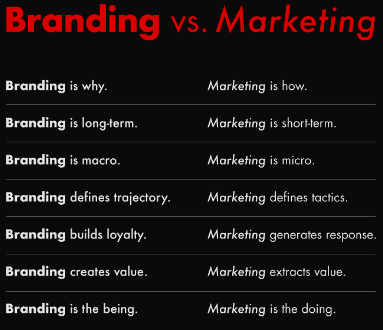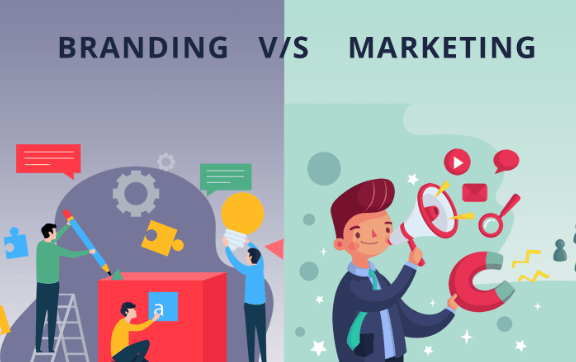Are you getting confused between the concepts of marketing and branding? You’re not alone. Many businesses struggle to differentiate these two critical aspects of a successful business strategy.
This blog will guide you through understanding the distinct roles and goals of marketing and branding while revealing how each contributes to your company’s success. Let’s dive in, shall we?.
Key Takeaways
- Marketing involves promoting and selling products or services, focusing on driving sales and grabbing audience attention in the short term.
- Branding is about creating a unique identity, building customer relationships, and establishing long – term brand recognition by shaping customer perception of a company’s values and image.
- Both marketing and branding are crucial for business success, with marketing tactics complementing branding efforts to drive revenue growth.
- Successful examples of branding and marketing campaigns include Nike’s “Just Do It,” Coca – Cola’s “Share a Coke,” and Apple’s “Get a Mac.”
Understanding the Difference Between Branding and Marketing

Both have distinct definitions, goals, and outcomes, but they are closely related in achieving overall business success.
Definitions of branding and marketing
Branding involves creating a unique name, logo, design, or symbol that identifies and differentiates a company’s products or services from others. It aims to establish a significant and recognizable presence in the market that attracts and retains loyal customers.
On the other hand, marketing is an active process of promoting and selling these products or services. This includes tactics like advertising, sales promotions, public relations efforts as well as researching consumer behavior to effectively position the product in the marketplace.
Differences in goals and outcomes
The goal of branding is to establish a strong company identity, create awareness, and build customer loyalty. It focuses on the long-term by shaping how customers perceive a brand’s values, image, and connection with its audience.
On the other hand, marketing aims to drive sales and acquire new customers in the short term. It grabs attention through advertising campaigns, promotions, and market research to understand consumer behaviour.
While the former builds relationships and recognition, marketing tactics are geared towards increasing sales and generating immediate results. Both strategies work together to achieve overall success for a company.

Both are closely intertwined, working together to achieve common goals. Marketing is the tactical aspect that focuses on promoting products or services, driving sales, and grabbing audience attention through advertising and promotions.
On the other hand, branding is a long-term strategy that aims to build customer relationships, establish company identity and values, and create brand recognition. The relationship between branding and marketing lies in their synergy – effective marketing campaigns rely on a strong brand identity to connect with consumers emotionally and differentiate from competitors.
By integrating branding into marketing efforts, companies can enhance their image, increase awareness, and ultimately drive sales through strategic messaging and positioning. Successful examples of this integration can be seen in various advertising campaigns where the brand’s values align with the target audience’s preferences resulting in increased loyalty and engagement.
The Importance of Branding
Branding plays a crucial role in building customer relationships, establishing company identity and values, and creating long-term brand recognition.
Building customer relationships and loyalty
Building customer relationships and loyalty is a crucial aspect of branding. By consistently delivering on promises and providing exceptional customer experiences, companies can establish trust and cultivate long-term relationships with their customers.
This involves understanding the needs and desires of the target audience, actively engaging with them through personalized interactions, and continuously seeking feedback to improve products or services.
Through effective branding strategies, businesses can create a loyal customer base that not only continues to support their brand but also becomes advocates who spread positive word-of-mouth recommendations.
Establishing company identity and values
Establishing company identity and values is a crucial aspect of branding. It involves determining who your company is, what it stands for, and what makes it unique. By defining your identity and values, you create a foundation that guides all of your business decisions and interactions with customers.
This helps to build trust and loyalty among your target audience, as they can align themselves with the values that your brand represents. In addition, having a strong company identity allows you to differentiate yourself from competitors in the market, making it easier for customers to recognize and remember your brand.
Through effective branding efforts, you can establish an authentic identity and set of values that resonate with your customers on a deeper level.
Creating long-term brand recognition
Branding plays a crucial role in creating long-term brand recognition. By consistently delivering on promises and providing quality products or services, companies can build trust and loyalty among customers.
Through effective branding strategies such as logo design, messaging, and visual identity, businesses can establish a distinct and recognizable image that resonates with their target audience.
Over time, this helps to solidify the brand’s position in the market and increase awareness among customers. With strong brand recognition comes increased customer loyalty and repeat business.
Also, understand the Difference between Brand Marketing and Product Marketing.
The Role of Marketing
Marketing plays a crucial role in driving sales, grabbing audience attention, and promoting products/services. Discover how marketing tactics and strategies contribute to the overall success of a business.
Driving sales and customer acquisition
Marketing plays a crucial role in driving sales and customer acquisition for a business. Through strategic advertising, promotions, and public relations efforts, marketing aims to capture the attention of the target market and promote the products or services being offered.
By conducting market research and analyzing consumer behavior, marketing teams can develop effective strategies to position their products or services in a way that meets customer needs and preferences.
This ultimately leads to increased sales opportunities and helps businesses expand their customer base. With its focus on generating immediate results, marketing complements branding efforts by translating brand identity into tangible actions that drive revenue growth.
Grabbing audience attention and promoting products/services
Marketing plays a crucial role in grabbing audience’s attention and promoting products/services. Through various tactics such as advertising, sales promotions, and public relations, marketing strategies are designed to create awareness and generate interest in what the company has to offer.
By understanding consumer behaviour and market research, marketers can identify the target audience’s needs and preferences, allowing them to tailor their messaging effectively. Whether it’s through captivating advertisements or compelling content, marketing is all about capturing the audience’s attention while showcasing the unique value of products or services.
In addition to grabbing attention, marketing also aims to promote products/services by highlighting their benefits and persuading customers to make a purchase. With strategic positioning and effective communication techniques, marketers can showcase how these offerings address specific customer needs and deliver value.
By leveraging comprehensive market research data on consumer behaviour trends, preferences, and demographics alongside effective advertising campaigns that resonate with the target audience’s desires or pain points—marketing helps businesses stand out from competitors while generating leads for potential customers.
Overall, marketing serves as a powerful tool for businesses to grab their audiences’ attention by promoting products/services in creative ways tailored specifically to their target markets.
Learn how Brand Managers are different from Marketing Managers.
Short-term tactics and strategies
Short-term tactics and strategies play a crucial role in marketing by focusing on immediate results. These tactics are designed to grab audience attention and drive sales in the short term.
Examples of short-term tactics include advertising campaigns, promotions, public relations, and market research. By using these tactics effectively, companies can quickly raise awareness, generate leads, and increase conversions.
While long-term branding efforts focus on building lasting customer relationships, short-term tactics help companies achieve their immediate goals and boost revenue. It’s important for businesses to strike a balance between long-term branding strategies and short-term marketing tactics to maximize their overall success.
The Synergy Between Branding and Marketing
Branding and marketing work together seamlessly to create a powerful synergy that drives business success.
How branding and marketing work together

Branding and marketing go hand in hand to create a powerful impact for companies. While branding builds the foundation of a company’s identity, values, and image, marketing is the vehicle that promotes this brand to the target audience.
By integrating their efforts, businesses can amplify their messages and increase customer engagement. For example, a strong brand identity helps marketing campaigns resonate with consumers on a deeper level.
Conversely, effective marketing tactics bring awareness to the brand and help build loyalty among customers. In essence, branding provides the framework for marketing strategies while marketing amplifies and reinforces the brand’s message in order to drive sales and achieve business goals.
Examples of successful branding and marketing campaigns
Successful branding and marketing campaigns can serve as great inspirations for businesses looking to make an impact in the market. One example of a successful campaign is Nike’s “Just Do It” slogan, which has become synonymous with the brand’s message of determination and empowerment.
This campaign not only helped Nike differentiate itself from competitors but also resonated with consumers on a deep emotional level.
Another example is Coca-Cola’s “Share a Coke” campaign, where personalized bottles were created with different names and phrases. This innovative approach allowed consumers to feel a personal connection to the brand, leading to increased customer loyalty and engagement.
The campaign was hugely successful in creating buzz and generating social media conversations.
Additionally, Apple’s “Get a Mac” advertising campaign featuring Justin Long as the cool Mac guy and John Hodgman as the nerdy PC guy was highly effective in positioning Apple products as sleek, modern, and superior.
By highlighting the key differences between Macs and PCs through relatable characters, this campaign successfully influenced consumer perceptions about Apple products.
The benefits of integrating branding and marketing efforts
Integrating branding and marketing efforts brings numerous benefits to a company. Firstly, it ensures consistency in messaging and visuals across all marketing channels, enhancing the brand’s recognition and memorability.
By aligning branding with marketing strategies, companies can create a strong and unified identity that resonates with their target audience. Additionally, integrating branding and marketing allows for a more cohesive customer experience, as the brand promise is communicated consistently throughout the buyer’s journey.
This integration also enables companies to build stronger customer relationships by establishing trust and loyalty through consistent messaging. Ultimately, by merging branding and marketing efforts, businesses can maximize their overall impact while driving sales and creating long-term brand value.
Conclusion
In conclusion, branding and marketing are both essential aspects of a successful business strategy. While branding focuses on building customer loyalty and establishing the identity and values of a company, marketing is geared towards driving sales, grabbing attention, and promoting products or services.
By integrating these two elements effectively, businesses can create strong brand recognition and connect with their target audience to achieve long-term success.
FAQs
What is the difference between marketing and branding?
Marketing involves tactical goals to promote a product or service, while branding is a strategy that defines the identity of your product positioning in the marketplace.
How does branding support marketing strategy?
Branding shapes brand management which sets guidelines for all marketing strategies, ensuring consistent messaging across all platforms.
Can I prioritize one over the other – Marketing vs Branding?
Both are important as they play different roles. While tactical goals in marketing can bring quick sales, an effective branding strategy provides long-term value and customer loyalty.
Does my small enterprise need both Branding and Marketing?
Yes! Regardless of your business size, having both strong branding and targeted marketing will help you stand out in competition and ensure sustained growth.




